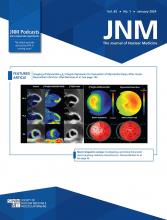In multiple myeloma, C-X-C motif chemokine receptor 4 (CXCR4) plays a pivotal role in cell migration, bone marrow infiltration, and resistance to therapy (1). Recently, CXCR4-directed theranostics has increasingly aroused clinical interest in the management of multiple myeloma, as CXCR4-directed PET/CT has proven a versatile tool both for detecting intra- and extramedullary manifestations (2,3) and for selecting patients who might benefit from chemokine receptor–directed therapy (4,5).
A 63-y-old woman with relapsed multiple myeloma was referred for further diagnostic work-up. After tandem autologous stem cell transplantation and maintenance therapy with lenalidomide, the patient experienced full-blown recurrence with disseminated intramedullary (90% infiltration of the bone marrow) and hepatic, renal, and cutaneous manifestations (as documented by [18F]FDG PET/CT and CD138 immunohistochemistry of a bone marrow biopsy [Fig. 1A]). Subsequently, treatment with daratumumab, bortezomib, and dexamethasone was initiated. However, 3 wk later, rapid further disease progression with multiple new intramuscular and cutaneous lesions was noticed. Therapy was changed to carfilzomib, cyclophosphamide, and dexamethasone, but only exerted a good response of intramedullary multiple myeloma (with a reduction of malignant plasma cells to 10%) and the renal manifestation.
(A) Maximum-intensity projection of [18F]FDG PET/CT (218 MBq, 60 min after injection), showing extensive CD138-positive intramedullary as well as hepatic, renal, and cutaneous (arrows) extramedullary lesions. Treatment with daratumumab, bortezomib, and dexamethasone was initiated. However, clinical progression with emergence of multiple new cutaneous lesions was noticed 3 wk later. (B) Subsequent planar whole-body scintigraphy with [99mTc]Tc-PentixaTec (470 MBq, 60 min after injection) depicts extensive CXCR4-positive cutaneous, subcutaneous, and intramuscular lesions (in contrast to good response of intramedullary multiple myeloma as proven by CD138 immunohistochemistry). (C) Immunohistochemistry staining of CD138 and CXCR4 of a subcutaneous lesion of thigh (black arrow, B) confirms marked chemokine receptor expression of nearly all malignant plasma cells.
Consequently, the possibility of CXCR4-directed endoradiotherapy was assessed. Whole-body imaging with the novel tracer [99mTc]Tc-N4-L6-CPCR4 ([99mTc]Tc-PentixaTec) was performed, demonstrating marked receptor expression of the cutaneous and intramuscular lesions (Fig. 1B). Histopathology of a cutaneous nodule on the right upper thigh confirmed infiltration by CXCR4-positive malignant clonal plasma cells (Fig. 1C).
Given the increasing clinical interest in noninvasive, in vivo CXCR4 visualization, [99mTc]Tc-PentixaTec as a receptor ligand for use in conventional imaging with its lower costs and general availability might prove an interesting alternative to CXCR4-targeting PET vectors.
DISCLOSURE
No potential conflict of interest relevant to this article was reported.
Footnotes
Published online Sep. 14, 2023.
- © 2024 by the Society of Nuclear Medicine and Molecular Imaging.
REFERENCES
- Received for publication July 7, 2023.
- Revision received August 22, 2023.








